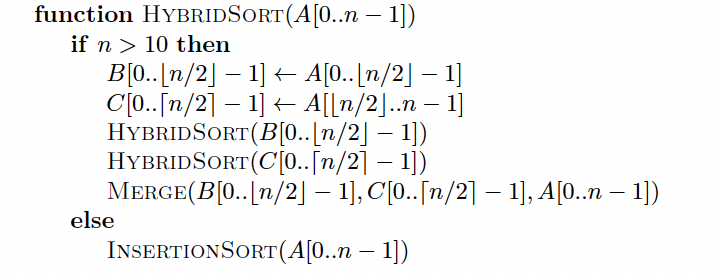Answered step by step
Verified Expert Solution
Question
1 Approved Answer
function HYBRIDSORT (A[0..n-1]) if n > 10 then B[0.. [n/2] 1] A[0..[n/2] 1] C[0..[n/2] -1] A[[n/2]..n 1] HYBRIDSORT (B[0..[n/2] 1]) HYBRIDSORT(C[0..[n/2] - 1]) MERGE(B[0..


function HYBRIDSORT (A[0..n-1]) if n > 10 then B[0.. [n/2] 1] A[0..[n/2] 1] C[0..[n/2] -1] A[[n/2]..n 1] HYBRIDSORT (B[0..[n/2] 1]) HYBRIDSORT(C[0..[n/2] - 1]) MERGE(B[0.. [n/2] 1], C[0..[n/2] 1], A[0..n 1]) INSERTIONSORT(A[0..n - 1]) else (a) Explain why this sorting algorithm takes less amount of time compared to INSERTIONSORT, when sorting a large collection of elements. (b) Explain why this sorting algorithm takes less amount of time compared to MERGESORT, when sorting a large collection of elements.
Step by Step Solution
★★★★★
3.46 Rating (153 Votes )
There are 3 Steps involved in it
Step: 1
The given algorithm is a hybrid sorting algorithm that combines two different sorting techniques a recursive divideandconquer approach similar to MergeSort for larger arrays and InsertionSort for smal...
Get Instant Access to Expert-Tailored Solutions
See step-by-step solutions with expert insights and AI powered tools for academic success
Step: 2

Step: 3

Ace Your Homework with AI
Get the answers you need in no time with our AI-driven, step-by-step assistance
Get Started


